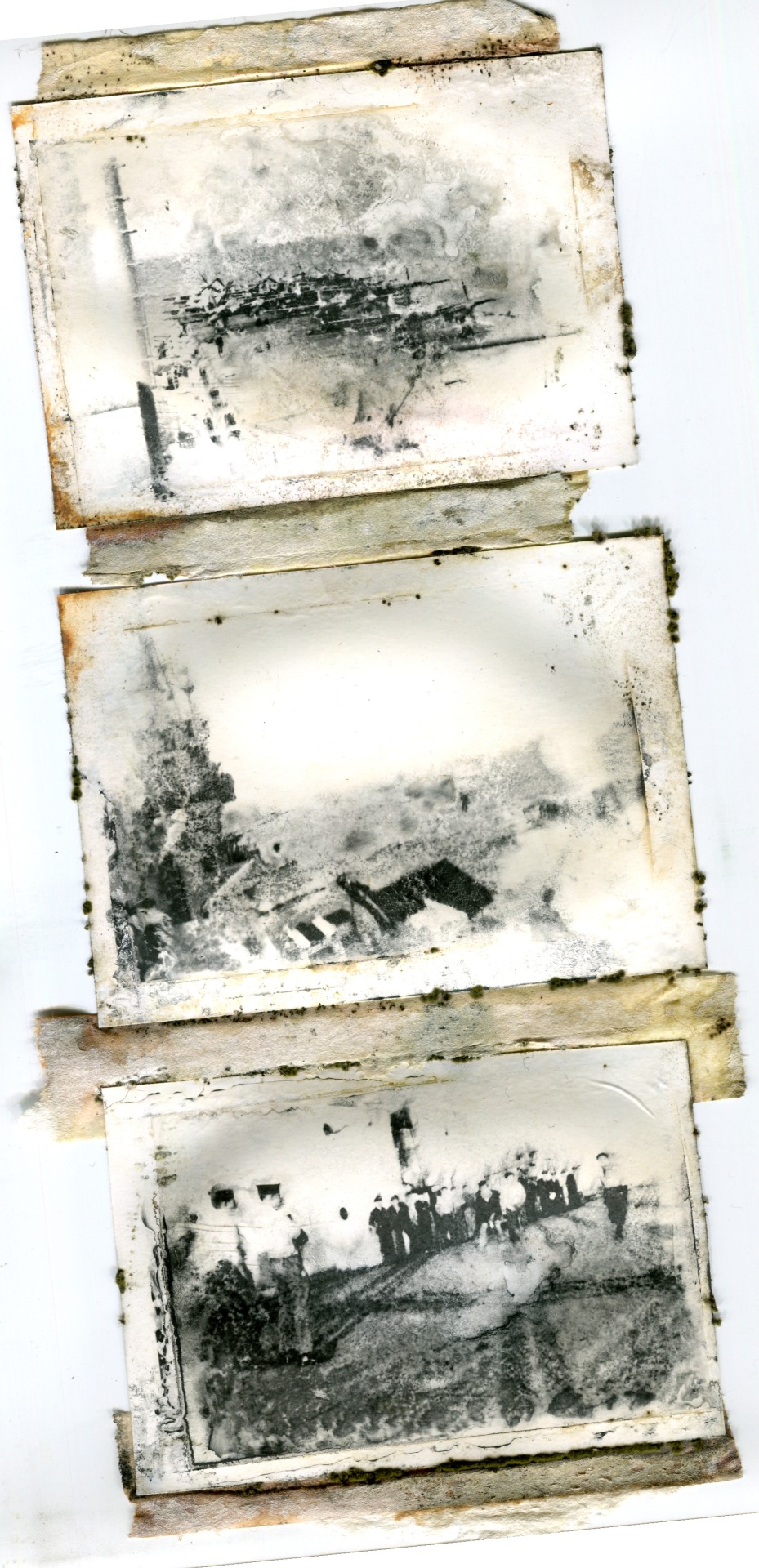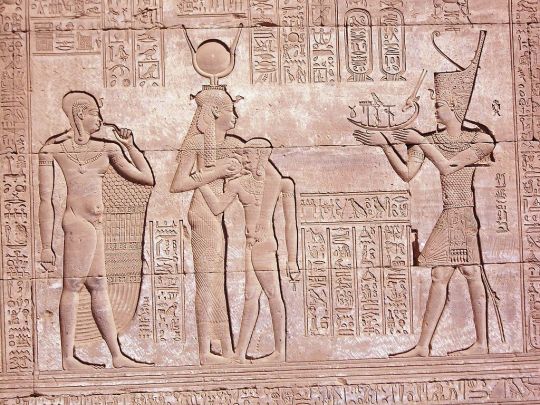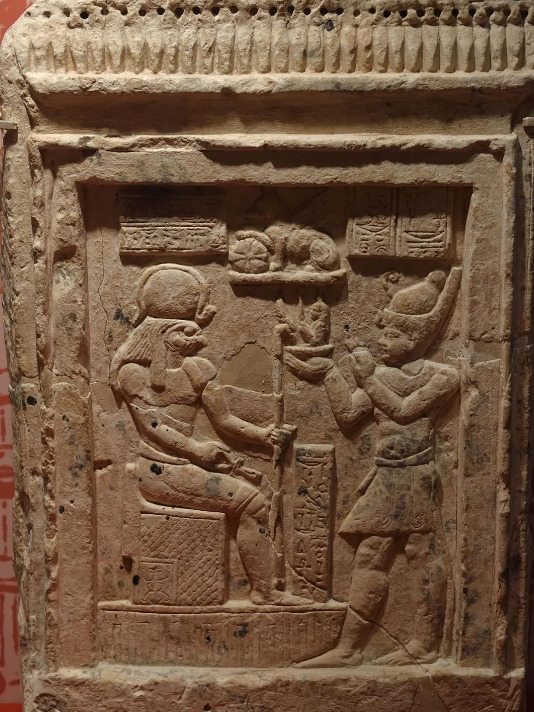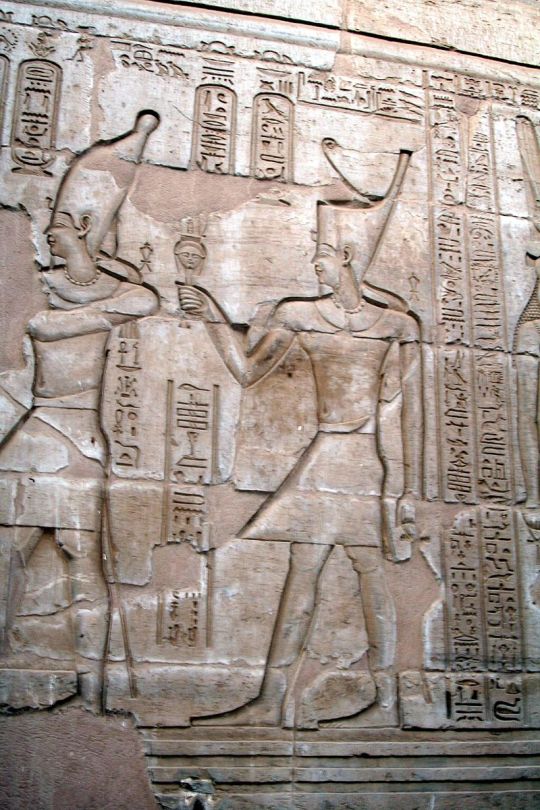Text




Recently I managed to save a framed set of photographs of HMS Vengeance (R71) from being consigned to oblivion in a skip. The frame dates from the the 1950's (I can't remember the exact dedication unfortunately), but I don't know when the phots were taken. Obviously, they have been very badly water damaged (hence their disposal) but I felt that I could at least save what I can for posterity. At some point I'll try and clean them up and remove that mould.
If anyone can gleam some more info as to when and where these were taken, I would love to hear it!
#hms vengeance#hms vengeance (r71)#colossus class#light aircraft carrier#royal navy#fleet air arm#photoset#reblog
6 notes
·
View notes
Text
The Roman Pharaohs of Ancient Egypt
In ancient history the pharaoh was the head of state and ruler of the country. However, he was not just a secular ruler, but a divine being on Earth who acted as an intermediary between the spiritual world and the earthly world. In essence he was a mortal representative of the gods. Interestingly, one did not have to be an Egyptian to be an Egyptian pharaoh. The act of conquering and ruling Egypt qualified one to be a pharaoh. As a result there were many foreign pharaohs throughout Egyptian history including those who were Persian, Nubian, Libyan, Hyksos, Kushite, and Macedonian Greek.
In 30 BC Cleopatra VII became the last ruler of Egypt from the Macedonian Greek Ptolemaic Dynasty. Cleopatra had backed the losing side of a Roman civil war, opposing Octavian and supporting Marc Antony. Octavian won, she was deposed, she committed suicide, and Egypt became a Roman province. When Octavian became Augustus and founded the Roman Empire, the Egyptians also recognized him as the official Pharaoh of Egypt. Afterwards successive Roman emperors were also declared pharaohs, until around the 4th century when Christianity became the dominant religion in Egypt.
Truth be told, most if not all Roman emperors didn't give a damn about being pharaohs. Most emperors never even stepped foot in Egypt and it didn't seem like they took their role as pharaoh very seriously. Regardless Egyptian iconography and art was crafted depicting Roman emperors in Egyptian style wearing Egyptian royal regalia and interacting with Egyptian gods. Some interesting examples are...
Gigachad Pharaoh Augustus

Tiberius

Nero

Nero again

Trajan making sacrifices to Hathor

Domitian

Domitian with Horus

Caracalla

Marcus Aurelius

95 notes
·
View notes
Text
Our confidence in Christ does not make us lazy, negligent or careless, but, on the contrary, it awakens us, urges us on and makes us active in living righteous lives and doing good. There is no self-confidence to compare with this.
Ulrich Zwingli
45 notes
·
View notes
Text

Hi everyone,
I am currently writing my bachelor thesis and it involves an online-survey which is available in German and English.
I would be ever so grateful if you could take part. It takes 10-15 minutes and everyone 18 years old or older is welcome. It is also 100% anonymous.
You can also share or reblog this post, the more participants the better.
Thanks to everyone for their support💙
Love, Sofia (ravenclawreign)
Click here ⬇️
9 notes
·
View notes
Text

US soldiers and a Sherman tank of the U.S. 3rd Army make their way down a country lane - Metz, north-east France; November 1944
#world war two#ww2#worldwar2photos#history#1940s#ww2 history#wwii#world war 2#ww2history#wwii era#Sherman#m4 Sherman#tank#american tanks#reblog
114 notes
·
View notes
Text

Near Lake Buchanan, Texas 🇺🇸
66 notes
·
View notes
Text




@military_vehicle_gallery
M5A1 Stuart Light Tank.
42 notes
·
View notes
Text

Camouflaged M60 tanks take firing positions on a road in West Germany, 1980
28 notes
·
View notes
Text

“Texas Spring”, 2019 by Norman Engel
#norman engel#texas artist#southwest art#texas art#texas hillcountry#nature#texas#landscape painting#landscape#reblog
152 notes
·
View notes
Text
Just for those that love the sound of freedom. Nothing But Jet Noise! 🔥
#usaf
#f-35alightningii
#fighterpilot
286 notes
·
View notes
Text
"Soon the battle will be over. It will not be long now before the day will come when our Enemy will no longer trouble us. There will be no more domination, temptation, accusation, or confrontation. Our warfare will be over and our commander, Jesus Christ, will call us away from the battlefield to receive the victor's crown."
~ Thomas Watson 1620-1686
#Watson#Thomas Watson#Watson quote#theology#christianity#appearing of Christ#second coming#hope#quote#reblog
27 notes
·
View notes
Photo

The Infrastructure of Caesarea Maritima
Caesarea Maritima, an ancient metropolis in modern-day Israel, was a remarkable engineering accomplishment. Extending Rome’s military and commercial presence in the eastern Mediterranean in the latter years of the 1st century BCE, Herod the Great (r. 37-4 BCE), as a client king, constructed a whole city complete with a temple, palaces, amphitheater, theater, paved streets, waterworks, and a colossal harbor.
The City’s East/West Plan
Built on the ruins of a Phoenician village called Straton’s Tower, the city of Caesarea Maritima and its harbor worked jointly to further Rome’s economic and military presence in the region. With its sanctioned location between the harbor and the city, the temple would also be an integrated part of all activity. As the harbor was the place receiving and initiating the export of goods, and the city was the administrative center for political and economic activity, the temple – as it harbored the sacred images of Julius Caesar as a god and Juno as the patron goddess of Rome – symbolized the bestowal of blessings and protection on the harbor and city. As Kenneth Holum relates, “the sacrificial festivals held at the temple were themselves quintessential urban moments” (57). As Herod and his planners had the advantage of starting new, they would create the main east/west plan of the city around the temple, starting with the harbor west at the temple’s foot, then with the adjacent construction of the city, east of the temple.
Continue reading…
31 notes
·
View notes
Text
The Final Hours of TITANIC - New 2024 Animation
youtube
6 notes
·
View notes
Note

Please make a post about the story of the RMS Carpathia, because it's something that's almost beyond belief and more people should know about it.
Carpathia received Titanic’s distress signal at 12:20am, April 15th, 1912. She was 58 miles away, a distance that absolutely could not be covered in less than four hours.
(Californian’s exact position at the time is…controversial. She was close enough to have helped. By all accounts she was close enough to see Titanic’s distress rockets. It’s uncertain to this day why her crew did not respond, or how many might not have been lost if she had been there. This is not the place for what-ifs. This is about what was done.)
Carpathia’s Captain Rostron had, yes, rolled out of bed instantly when woken by his radio operator, ordered his ship to Titanic’s aid and confirmed the signal before he was fully dressed. The man had never in his life responded to an emergency call. His goal tonight was to make sure nobody who heard that fact would ever believe it.
All of Carpathia’s lifeboats were swung out ready for deployment. Oil was set up to be poured off the side of the ship in case the sea turned choppy; oil would coat and calm the water near Carpathia if that happened, making it safer for lifeboats to draw up alongside her. He ordered lights to be rigged along the side of the ship so survivors could see it better, and had nets and ladders rigged along her sides ready to be dropped when they arrived, in order to let as many survivors as possible climb aboard at once.
I don’t know if his making provisions for there still being survivors in the water was optimism or not. I think he knew they were never going to get there in time for that. I think he did it anyway because, god, you have to hope.
Carpathia had three dining rooms, which were immediately converted into triage and first aid stations. Each had a doctor assigned to it. Hot soup, coffee, and tea were prepared in bulk in each dining room, and blankets and warm clothes were collected to be ready to hand out. By this time, many of the passengers were awake–prepping a ship for disaster relief isn’t quiet–and all of them stepped up to help, many donating their own clothes and blankets.
And then he did something I tend to refer to as diverting all power from life support.
Here’s the thing about steamships: They run on steam. Shocking, I know; but that steam powers everything on the ship, and right now, Carpathia needed power. So Rostron turned off hot water and central heating, which bled valuable steam power, to everywhere but the dining rooms–which, of course, were being used to make hot drinks and receive survivors. He woke up all the engineers, all the stokers and firemen, diverted all that steam back into the engines, and asked his ship to go as fast as she possibly could. And when she’d done that, he asked her to go faster.
I need you to understand that you simply can’t push a ship very far past its top speed. Pushing that much sheer tonnage through the water becomes harder with each extra knot past the speed it was designed for. Pushing a ship past its rated speed is not only reckless–it’s difficult to maneuver–but it puts an incredible amount of strain on the engines. Ships are not designed to exceed their top speed by even one knot. They can’t do it. It can’t be done.
Carpathia’s absolute do-or-die, the-engines-can’t-take-this-forever top speed was fourteen knots. Dodging icebergs, in the dark and the cold, surrounded by mist, she sustained a speed of almost seventeen and a half.
No one would have asked this of them. It wasn’t expected. They were almost sixty miles away, with icebergs in their path. They had a respondibility to respond; they did not have a responsibility to do the impossible and do it well. No one would have faulted them for taking more time to confirm the severity of the issue. No one would have blamed them for a slow and cautious approach. No one but themselves.
They damn near broke the laws of physics, galloping north headlong into the dark in the desperate hope that if they could shave an hour, half an hour, five minutes off their arrival time, maybe for one more person those five minutes would make the difference. I say: three people had died by the time they were lifted from the lifeboats. For all we know, in another hour it might have been more. I say they made all the difference in the world.
This ship and her crew received a message from a location they could not hope to reach in under four hours. Just barely over three hours later, they arrived at Titanic’s last known coordinates. Half an hour after that, at 4am, they would finally find the first of the lifeboats. it would take until 8:30 in the morning for the last survivor to be brought onboard. Passengers from Carpathia universally gave up their berths, staterooms, and clothing to the survivors, assisting the crew at every turn and sitting with the sobbing rescuees to offer whatever comfort they could.
In total, 705 people of Titanic’s original 2208 were brought onto Carpathia alive. No other ship would find survivors.
At 12:20am April 15th, 1912, there was a miracle on the North Atlantic. And it happened because a group of humans, some of them strangers, many of them only passengers on a small and unimpressive steam liner, looked at each other and decided: I cannot live with myself if I do anything less.
I think the least we can do is remember them for it.
260K notes
·
View notes
Text
“History is not composed of a series of discrete events, incidents that, like a collection of motion pictures, have clearly defined beginnings and endings…And yet the sinking of the Titanic, in those hours between 11:40 PM on April 14 and 8:30 AM on April 15, 1912, was one of those rare finite events that history on occasion does afford humanity. It illuminated with stark, sometimes harsh, clarity the strengths and weaknesses, virtues and flaws of the society that gave impetus to her existence. In those nine hours, the men and women aboard the Titanic demonstrated almost ever derogatory characteristic of Edwardian society: arrogance, pride, snobbery, prejudice, racism, chauvinism, and maudlin sentimentality. They also showed in equal measure the Edwardians’ capacity for self-confidence, self-reliance, self-sacrifice, gallantry, noblesse oblige, and devotion to duty. In many ways, what makes the Titanic disaster so compelling is that it catches Edwardian society at its pinnacle; before the decade was out it would have vanished forever.”
— Unsinkable, Daniel Allen Butler
6 notes
·
View notes
Text
““All historians understand that history passes into legend and legend into myth, and it is the historian’s duty to do his best to scrape away encrusted layers of fiction and fantasy to reach the underlying truth, at least as he or she can best understand it. It is also the historian’s responsibility to give interpretation and, ultimately, meaning, to the truth he or she finds. For the Titanic disaster, that vital, enduring, fundamental truth is in realizing that it was more than a truly terrible thing that happened, through no direct fault of their own, to a group of essentially good people. It was a truly terrible event in which some men and women of every social station, passenger and crew alike, rose above themselves to confront Fate face-to-face, and would not "go gentle into that good night.” They became the men and women who, through living or dying, in their refusal to passively accept the circumstances in which they had become ensnared, struggled for their own lives and the lives of others. They are the men and women who would be remembered as the heroes of the Titanic disaster. For those to whom the Titanic disaster was and remains more than a fleeting interest, the true meaning and example of the word “hero” has long been etched in their consciences and souls, indelibly defined by the events in the middle of the Atlantic Ocean on that cold April night in 1912. It was the image of Engineer Herbert Harvey, down in Boiler Room No. 5, rushing into a rising tide of water in a vain, valiant effort to save his colleague Jonathan Shepherd. It was Jack Phillips, already exhausted after spending nearly eighteen hours working at his wireless set, remaining at his key, still desperately tapping out yet another call for help even as the Titanic’s power failed. It was the men in Second Class, willingly staying out of the lifeboats—nine of every ten of them would die with the ship. It was the ship’s orchestra, playing literally to the bitter end. It was Edith Evans, giving up her seat in Collapsible D to Mrs. Brown—the last seat in the last lifeboat. It was 18-year-old Daniel Marvin seeing his equally young bride of three weeks into Boat 10, then stepping back onto the Titanic’s deck. It was Ben Guggenheim, “playing the man’s game to the end,” donning white tie and tails so that he could die as he felt a gentleman should. It was the Titanic’s engineers, all of them staying below, knowing they were doing so at the cost of their own lives, to keep the power up and the lights burning. It was Second Office Lightoller, refusing to give up, organizing the men on the keel of Collapsible B, keeping them alive until the Carpathia arrived. It was the crewman, whose name remains unknown to this day, who gave his own lifebelt to Minnie Coutts with the words “remember me.” It was all of them, and more—for surely there were stories of courage and sacrifice which were never told and can never be told, because all those who witnessed them were lost with the ship. It is for them that the Titanic, “name and thing,” should and will be remembered, for they were, all of them, quite ordinary people, much as we are today. It was their fate, and their triumph, that when asked by circumstances to become extraordinary, they found within themselves the determination, like Ulysses, “to strive, to seek, to find, and not to yield.”“”
— (via girlwithakiwi)
15 notes
·
View notes